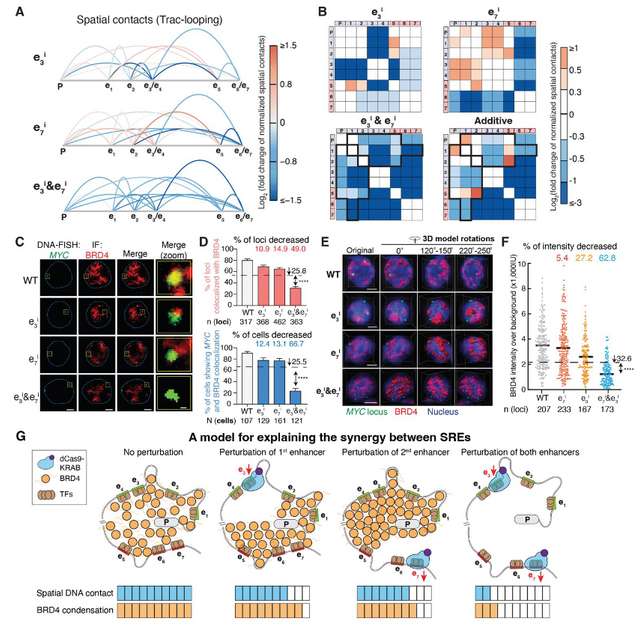Nested Epistasis Enhancer Networks For Robust Genome Regulation
Nested Epistasis Enhancer Networks For Robust Genome Regulation: Unraveling the Secrets of Genetic Control Introduction In the world of science and genetics, researchers at Science.org have made groundbreaking discoveries in understanding how epistasis enhancer networks play a vital role in robust genome regulation. This article delves into the fascinating realm of nested epistasis enhancer networks, exploring their significance in genome regulation and how they contribute to the overall understanding of genetic control. 1. The Basics of Epistasis Enhancer Networks Epistasis enhancer networks refer to the complex interactions between enhancer elements within a genome, which modify the expression of genes. These networks play a pivotal role in fine-tuning the regulation of genes, influencing various cellular processes and phenotypic outcomes. Nested epistasis enhancer networks, in particular, are a more intricate and intertwined form of these regulatory systems. 2. Unraveling the Complexity of Nested Epistasis Enhancer Networks Nested epistasis enhancer networks are characterized by their hierarchical structure, where multiple layers of regulatory interactions occur. At each level, specific enhancers interact with other enhancers within the same layer and those at higher or lower levels. This hierarchical organization allows for precise fine-tuning of gene expression and robustness in the face of environmental and genetic perturbations. To better understand the complexity of nested epistasis enhancer networks, researchers at Science.org conducted extensive studies using cutting-edge genomic technologies, such as CRISPR-Cas9 gene editing and high-throughput sequencing. These investigations revealed the existence of intricate enhancer interactions, unveiling previously unknown layers of genetic control. 3. Unveiling the Mechanisms Behind Robust Genome Regulation Nested epistasis enhancer networks are critical for robust genome regulation. By studying the hierarchical structure of these networks, researchers have been able to shed light on the mechanisms that govern gene expression and phenotypic variation. One key mechanism observed is how higher-level enhancers act as "master regulators" by simultaneously controlling the expression of multiple genes within nested networks. This orchestration ensures coordinated gene expression and robustness of phenotypic outcomes. Moreover, nested enhancer networks provide additional layers of redundancy, safeguarding against perturbations and promoting stable gene expression in various genetic and environmental contexts. 4. Implications in Biomedical Research and Therapeutics The discoveries surrounding nested epistasis enhancer networks have far-reaching implications in the field of biomedical research and therapeutics. Understanding the intricacies of gene regulation opens new avenues for developing targeted therapies and interventions for genetic disorders. By precisely manipulating specific layers within nested enhancer networks, researchers can potentially modulate gene expression and correct abnormalities associated with genetic diseases. This newfound knowledge may revolutionize the field of gene therapy, offering promising possibilities for tailored treatments that address the root causes of various genetic disorders. FAQ: Q: How are nested epistasis enhancer networks different from regular enhancer networks? A: Nested epistasis enhancer networks are more complex and hierarchical in nature, featuring multiple layers of enhancer interactions. Regular enhancer networks typically involve simpler interactions between individual enhancers and their target genes. Q: How can the understanding of nested epistasis enhancer networks improve precision medicine? A: By unraveling the mechanisms behind nested epistasis enhancer networks, researchers can identify key regulatory elements that contribute to genetic diseases. This knowledge can aid in the development of targeted therapies that address specific genetic abnormalities, ultimately improving precision medicine approaches. Q: Are nested epistasis enhancer networks found in all organisms? A: While nested epistasis enhancer networks have been extensively studied in model organisms such as mice and fruit flies, their presence and complexity may vary across different species. Further research is needed to explore the prevalence and variations of nested enhancer networks in various organisms. Conclusion Nested epistasis enhancer networks are pivotal components of robust genome regulation, offering insights into the fine-tuning of gene expression and phenotypic outcomes. The discoveries made by scientists at Science.org shed light on this intricate regulatory system and its implications in biomedical research and therapeutics. As research in this field continues to advance, we can anticipate exciting developments that will reshape our understanding of genetic control and pave the way for innovative treatments for genetic disorders.  Image Source : www.science.org
Image Source : www.science.org  Image Source : vitomag.com
Image Source : vitomag.com  Image Source : vitomag.com
Image Source : vitomag.com  Image Source : www.science.org
Image Source : www.science.org  Image Source : www.researchgate.net
Image Source : www.researchgate.net  Image Source : www.science.org
Image Source : www.science.org  Image Source : www.science.org
Image Source : www.science.org  Image Source : www.researchgate.net
Image Source : www.researchgate.net
Nested Epistasis Enhancer Networks For Robust Genome Regulation | Science
 Image Source : www.science.org
Image Source : www.science.org Science丨亓磊團隊揭示增強子嵌套多層結構調節基因組 - VITO雜誌
 Image Source : vitomag.com
Image Source : vitomag.com Science丨亓磊團隊揭示增強子嵌套多層結構調節基因組 - VITO雜誌
 Image Source : vitomag.com
Image Source : vitomag.com Nested Epistasis Enhancer Networks For Robust Genome Regulation | Science
 Image Source : www.science.org
Image Source : www.science.org (PDF) Nested Epistasis Enhancer Networks For Robust Genome Regulation
 Image Source : www.researchgate.net
Image Source : www.researchgate.net Nested Epistasis Enhancer Networks For Robust Genome Regulation | Science
 Image Source : www.science.org
Image Source : www.science.org Nested Epistasis Enhancer Networks For Robust Genome Regulation | Science
 Image Source : www.science.org
Image Source : www.science.org Figure S1: Illustration Of The Genomic And Sequence Features Used, See
 Image Source : www.researchgate.net
Image Source : www.researchgate.net Figure s1: illustration of the genomic and sequence features used, see. (pdf) nested epistasis enhancer networks for robust genome regulation. Nested epistasis enhancer networks for robust genome regulation. Nested epistasis enhancer networks for robust genome regulation. Nested epistasis enhancer networks for robust genome regulation